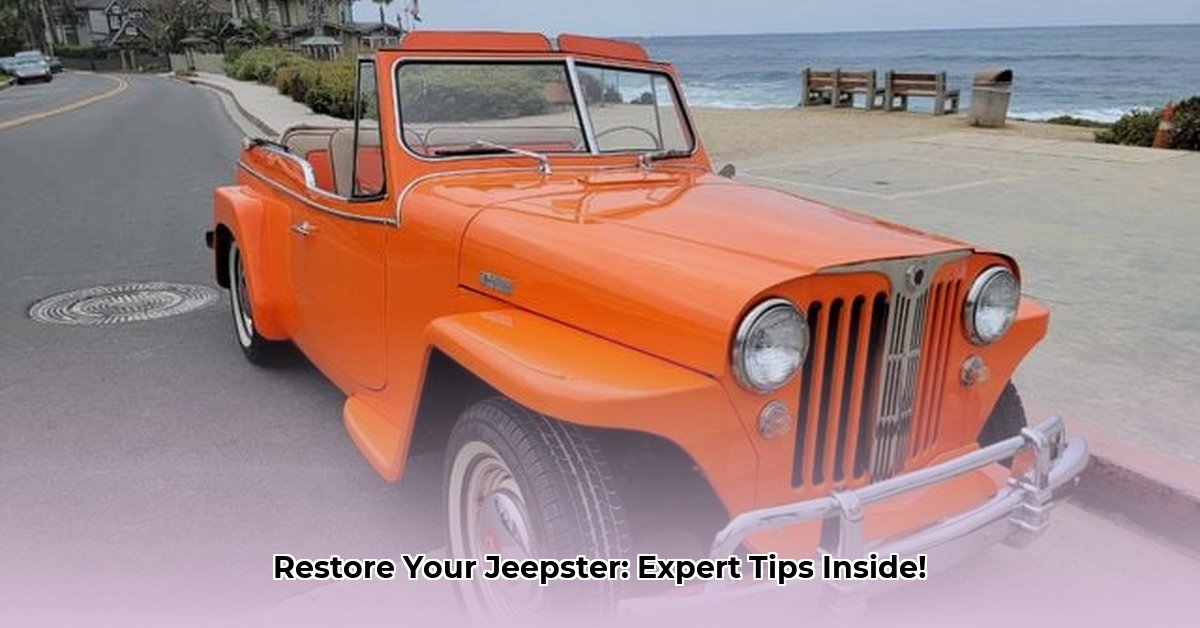
Ever dreamed of owning a classic Jeepster, that iconic blend of ruggedness and style? Restoring one is a challenging but incredibly rewarding journey. This isn't just about wrenching and welding; it's about the entire process, from sourcing the right Jeepster to that final, gleaming polish. We'll cover everything you need to know – parts sourcing (it's tougher than you think!), step-by-step restoration, budgeting (brace yourself!), and finding experienced mechanics. Whether you're a seasoned pro or a curious enthusiast, this guide will help bring your Jeepster dream to life.
The Jeepster Restoration Landscape: A Market Overview
The demand for restored Jeepsters is surprisingly robust, driven by their history, rugged charm, and the spirit of adventure they evoke. It's more than transportation; it's a statement. Major players like Willys America (a nearly four-decade veteran) and Specialty Jeeps offer full restoration services—but be warned: significant hurdles exist. Sourcing original parts, especially for pre-1960s models, is notoriously difficult. Skilled mechanics experienced with Jeepsters are a rare find. This creates both opportunities and serious challenges. Isn't the rarity of both parts and skilled labor a key factor driving up restoration costs? Let's dive into the specifics.
A Step-by-Step Jeepster Restoration Plan
This isn't a weekend project; restoring a Jeepster is a marathon, not a sprint. This guide breaks down the process into manageable sections.
1. Assessment and Planning: Laying the Foundation
- Condition Assessment: Begin with a thorough inspection. Photograph everything – close-ups, wide shots, everything. Identify what needs fixing, what's salvageable, and what's beyond repair. This informs your entire project.
- Realistic Budgeting: Restoring a car is expensive. Create a detailed budget, encompassing parts, labor, tools, and those inevitable surprises. Overestimate rather than under; many projects double or even triple initial estimates. A 20% contingency fund is a good starting point.
- Parts Sourcing Strategy: This is crucial. Start early. Online marketplaces, salvage yards, and specialist suppliers are your best bets. Building relationships with these suppliers is key to securing hard-to-find parts. Finding the correct parts is 75% of the project; you'll be surprised at how much time this step consumes.
2. Disassembly: A Methodical Deconstruction
- Organized Removal: Disassemble methodically, photographing each step. Numbering parts is highly recommended. Organize and label everything clearly; it's like creating a complex puzzle you'll later reassemble.
- Protecting Parts: Storage is vital. Use protective coatings or wraps. Store metal parts in a moisture-free, rust-inhibiting system.
3. Restoration: Bringing Back to Life
- Bodywork: Rust repair, dent removal, and repainting are often major undertakings. Professional help might be needed for significant damage.
- Mechanical Revival: Engine and transmission rebuilds (or replacements) are likely necessities. The same goes for brakes, steering, and the electrical system. Seek a skilled mechanic familiar with vintage vehicles.
- Interior Refresh: Upholstery, panels, and carpeting make a huge difference. Professional help can often ensure quality and save you time.
4. Reassembly: Precision and Patience
- Methodical Reintegration: Use your photos and notes. Take your time; rushing creates errors and delays.
- Systemic Testing: Test each system (engine, brakes, electrical) independently as you go to identify problems early.
5. Testing and Refinement: Fine-Tuning for Success
- Comprehensive Checks: Thorough testing is crucial. Rigorous testing is the only way to discover unseen problems.
- Adjustments and Tweaks: Make adjustments to ensure smooth operation and performance.
6. Finishing Touches: The Grand Finale
- Meticulous Detailing: Clean, polish, and wax for that final layer of protection.
- Final Inspection: A comprehensive final inspection is non-negotiable.
Sourcing Parts and Securing Skilled Labor
Finding parts can be a significant challenge. Jeep-specific online communities and forums are goldmines of information. They often help connect enthusiasts with hard-to-find items or specialists. Building relationships with suppliers is invaluable.
Finding mechanics experienced with classic Jeeps is another hurdle. Word-of-mouth referrals are highly valued. If your budget is tight, consider DIY restoration, using readily available online courses and resources. How many hours should one allocate weekly to a DIY Jeepster restoration project to complete it within a reasonable timeframe?
Budgeting and Timelines: Realistic Expectations
Restorations are costly endeavors. Budget at least $20,000-$50,000 (or more, depending on the Jeepster's condition and the amount of work required). Expect this to be a significant time investment – anywhere from a year to several extended years.
Conclusion
Restoring a Jeepster is a journey demanding commitment and patience, but the satisfaction is immense. This guide provides a framework. Embrace the process, and enjoy the reward of bringing this classic vehicle back to life.
Resources
While specific websites are beyond the scope of this article, simple online searches for "Jeepster restoration forums" or "Willys Jeep parts suppliers" provide excellent starting points. Connecting with other enthusiasts and experts is an invaluable step in the process.